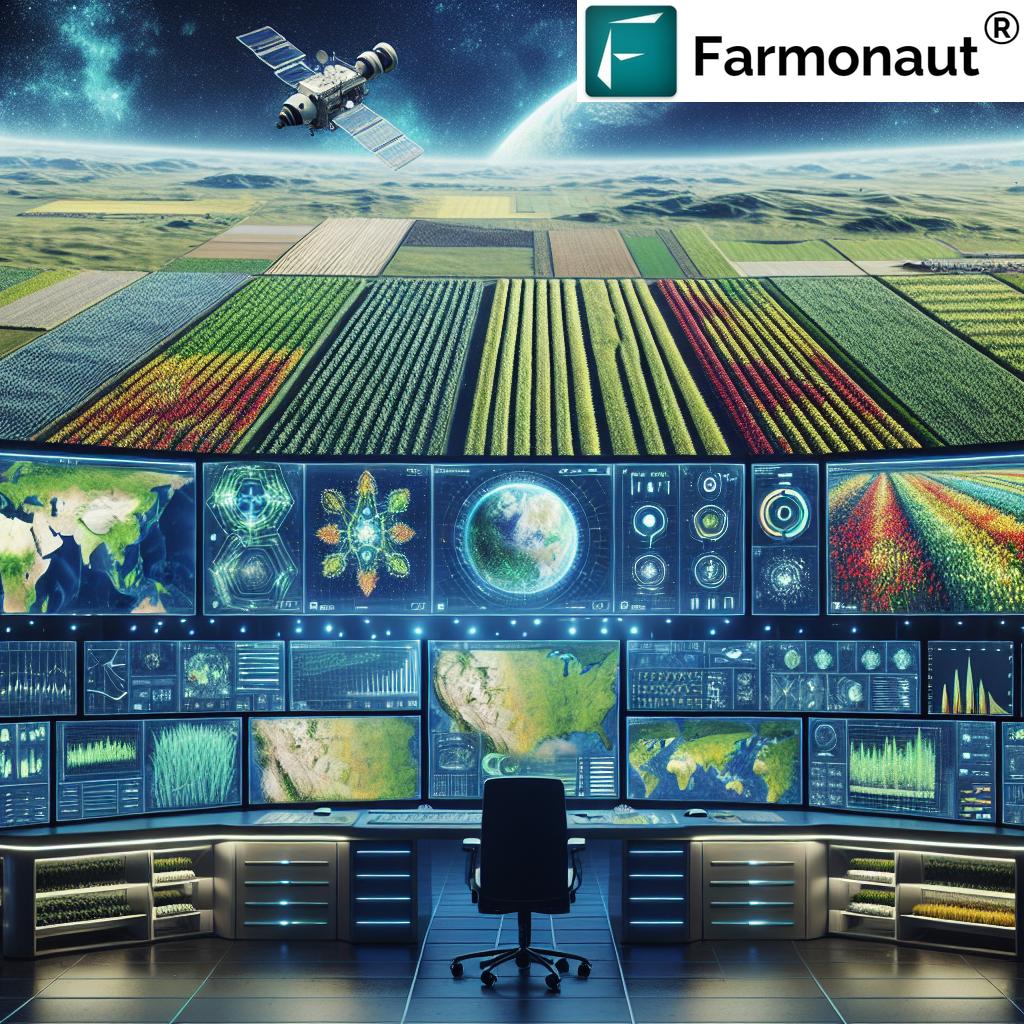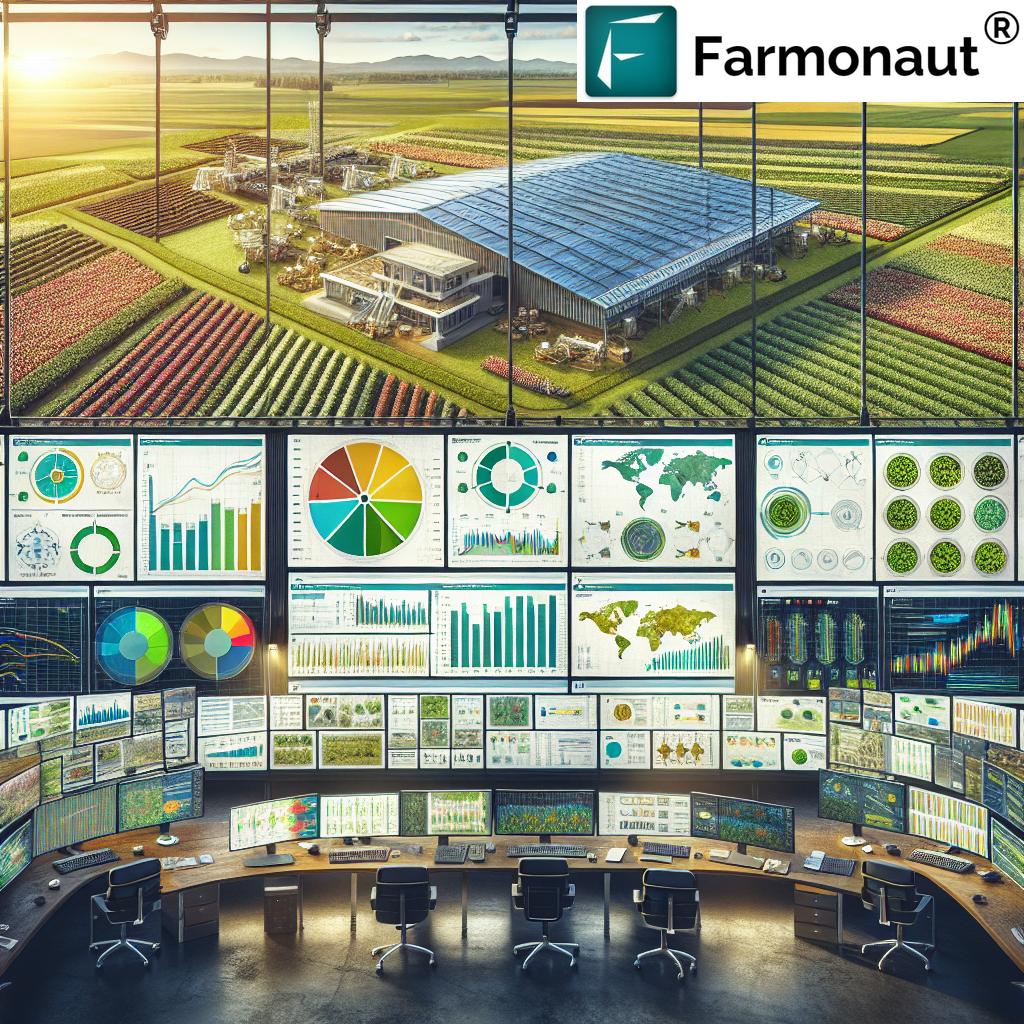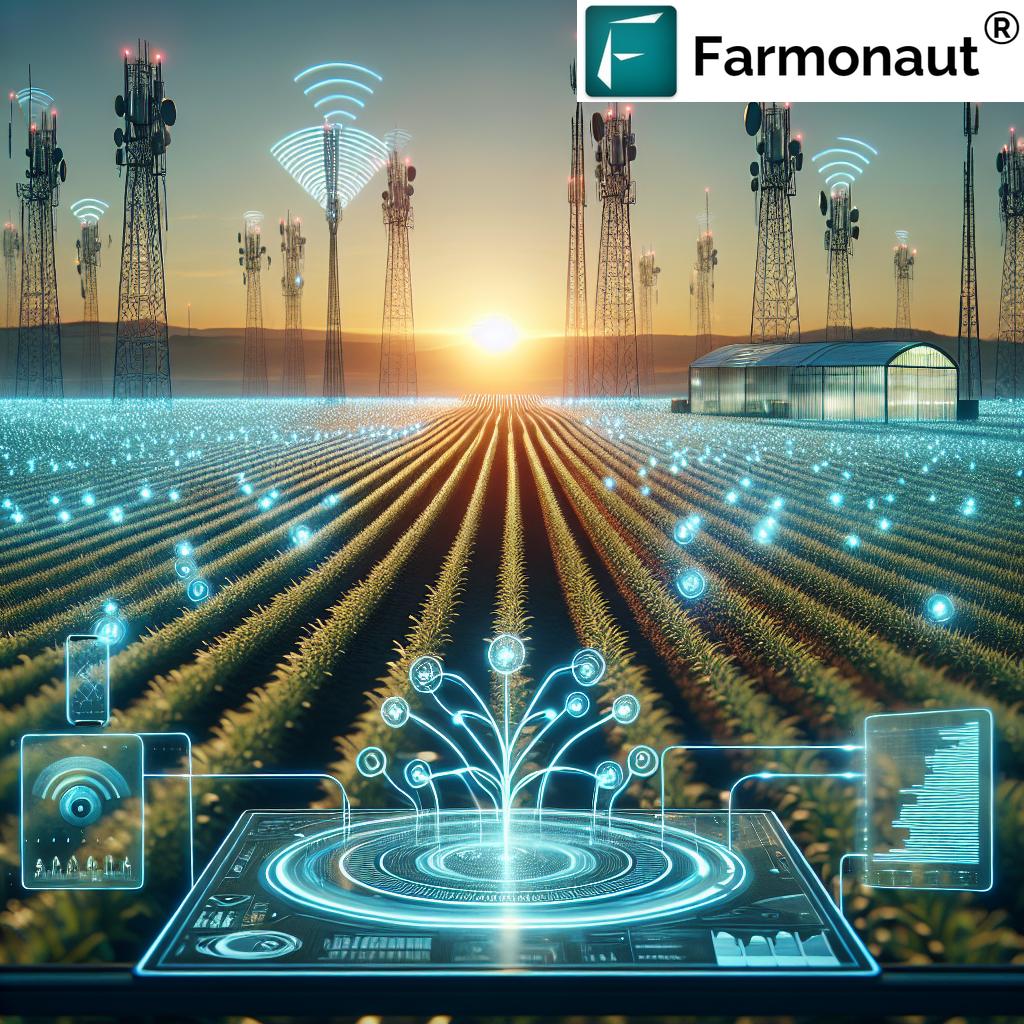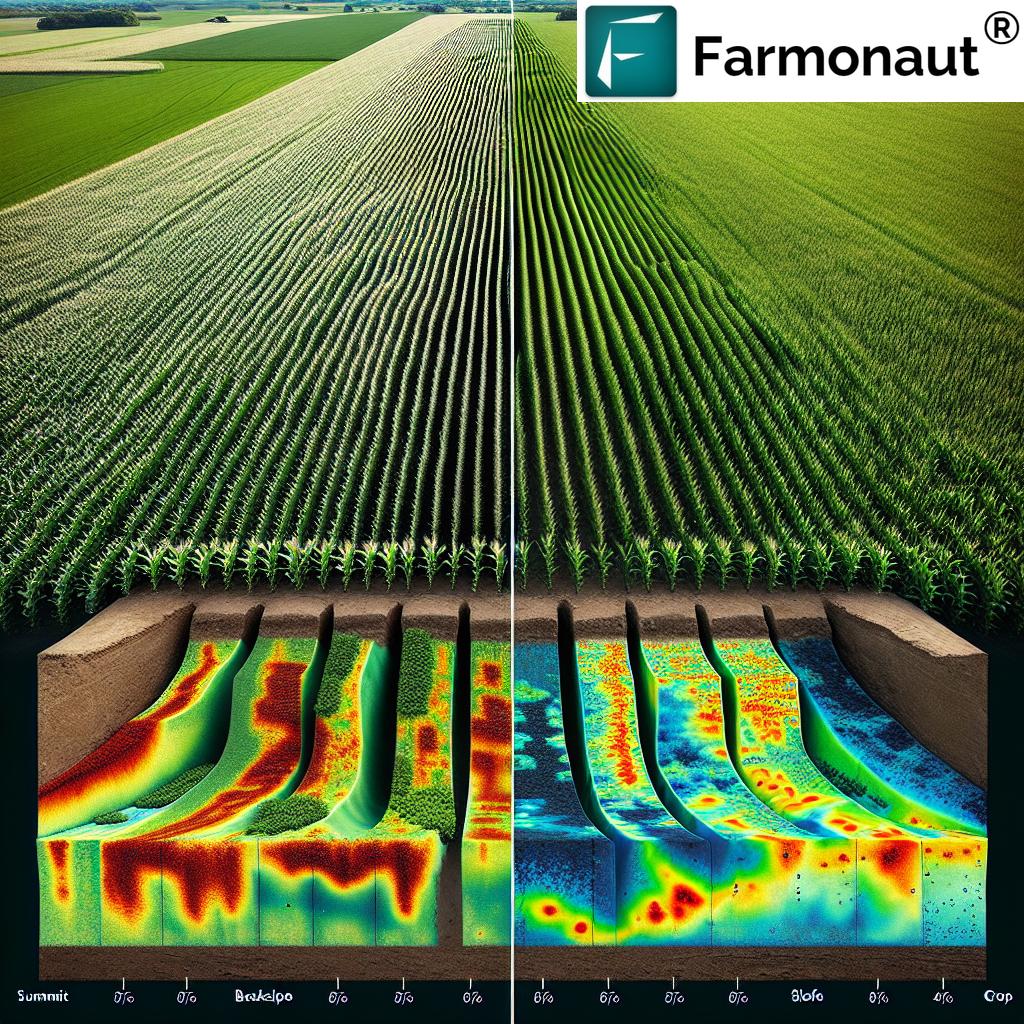Autonomous Agricultural Machinery Market: 2025 Trends
Table of Contents
- Introduction: Autonomous Agricultural Machinery Market in 2025
- How Autonomous Agricultural Machinery is Transforming Modern Farming
- Key Drivers Propelling the Autonomous Farm Machinery Market
- Core Benefits: Precision, Efficiency, and Sustainability
- Technological Innovations Shaping Autonomous Machinery in Agriculture
- Comparative Trends Table: Autonomous vs. Traditional Machinery 2025
- Global Market Outlook, Key Regions & 2025 Adoption Patterns
- Challenges Facing the Autonomous Agricultural Machinery Market
- Farmonaut: Accelerating Precision Agriculture Affordably
- Key Trends Shaping the Future of Autonomous Agricultural Machinery
- FAQ on Autonomous Farming Technology & Market Trends
- Conclusion: The Road Ahead for Autonomous Farm Machinery
Introduction: Autonomous Agricultural Machinery Market in 2025
The autonomous agricultural machinery market stands at the epicenter of a new revolution in farming. Entering 2025, autonomous solutions are rapidly transforming the landscape of modern agriculture, forestry, and rural operations. Advanced technologies — including artificial intelligence (AI), machine learning, computer vision, GPS, and cutting-edge sensors — are fueling machinery capable of operating independently with minimal human intervention.
Autonomous agricultural machinery refers to equipment such as tractors, planters, harvesters, sprayers, and drones designed to perform specialized tasks automatically, helping farmers improve productivity, reduce labor dependency, and promote sustainable practices. These developments reflect global trends in food demand, sustainability, technology integration, and the ongoing labor crunch in rural communities. As we approach 2025, the sector promises to revolutionize farming by enhancing efficiency, maximizing yields, and optimizing resource management — all vital for feeding a booming global population.
This comprehensive guide explores cutting-edge autonomous machinery in agriculture, delivering clear, factual, and actionable insights for stakeholders across the agricultural spectrum.
How Autonomous Agricultural Machinery is Transforming Modern Farming
Technological progress isn’t just a footnote in agriculture — it is rewriting the rulebook. The autonomous agricultural machinery market unleashes machines and systems that work independently, 24/7, with minimal human intervention. Leveraging real-time data, AI, and machine learning, these systems perform everything from seed planting to precise pesticide spraying, reducing errors and maximizing productivity.
- Consistency & Precision: Unlike traditional machinery, autonomous solutions execute agricultural operations like planting, thinning, weeding, fertilizing, and harvesting with unwavering consistency and minimal variance.
- Round-the-Clock Productivity: Freed from human fatigue and scheduling barriers, autonomous machinery can work day and night, optimizing field usage and meeting tight planting and harvesting windows.
- Minimized Environmental Impact: By enabling targeted application of fertilizers and pesticides, autonomous technologies substantially reduce overuse and contamination risk, supporting environmentally conscious practices.
- Labor Independence: Tackling labor shortages, these machines automate repetitive, physically demanding tasks — a game-changer as many regions face a decline in available farm labor.
Watch: How AI Drones Are Saving Farms & Millions in 2025 ?
Key Drivers Propelling the Autonomous Farm Machinery Market
The rapid rise of autonomous machinery in agriculture is fueled by pivotal drivers reshaping the market:
- Labor Shortages: The rural exodus and aging workforce limit the availability of skilled farm labor globally, especially across North America, Europe, and parts of Asia-Pacific.
- Increasing Food Demand: By 2050, global food production must rise by at least 50% — making efficiency and yield optimization cornerstones for future farming strategies.
- Push for Sustainability: Governments and NGOs emphasize digital agriculture and resource conservation, positioning automation as a vital sustainability tool for reducing environmental footprints.
- Technological Innovation: Major advances in sensors, AI, GPS, computer vision, robotics, and data analytics push the boundaries of what agricultural machines can accomplish independently.
- Cost Pressures: With rising operational expenses, autonomous farm machinery offers pathways to significant cost savings over time, despite upfront investment.
Watch: 2025 Veg Equipment Boom ? Smart Farming, AI Telematics & Market Trends
“Farmers and communities face growing operational and economic constraints, and autonomous machinery offers a timely, scalable solution.”
Autonomous agricultural machinery market growth is most pronounced where technology adoption is high, but momentum is building everywhere as the benefits become clearer and costs trend downward.
Core Benefits of Autonomous Machinery in Agriculture: Precision, Efficiency, and Sustainability
Autonomous farming machinery delivers a suite of advantages that extend beyond labor savings:
- Consistent Precision: Automated equipment, leveraging advanced GPS and AI, performs crucial tasks (e.g., seeding, spraying, fertilizing) with unparalleled accuracy, eliminating manual errors and optimizing inputs.
- Resource Optimization: By precisely administering seeds, water, fertilizers, and pesticides, these machines reduce waste, save money, and minimize environmental risks such as groundwater contamination.
- Scalability: Autonomous systems allow small and large farms alike to efficiently scale up operations without proportionally increasing labor needs. Each machine can cover more ground faster.
- Minimized Human Exposure: The most dangerous tasks — like spraying chemicals or working rough terrain — are handled by machines, reducing risks to human health.
- Data-Driven Management: These machines continuously collect and transmit real-time data on crop, soil, and field conditions, enabling rapid adjustments and improved decision-making.
Technological Innovations Shaping Autonomous Machinery in Agriculture
The autonomous agricultural machinery market thrives on continuous technological advancement. 2025 showcases a blend of several innovation streams:
1. Artificial Intelligence and Machine Learning
- AI algorithms: Power autonomous navigation, obstacle avoidance, predictive maintenance, and adaptive decision-making across various terrains and crops.
- Machine learning: Improves system performance over time, allowing machines to self-optimize tasks such as variable-rate spraying or targeted weeding.
2. Advanced Sensing, GPS, and Computer Vision
- GPS-guided navigation: Keeps machines precisely on track, critical for straight planting rows, aligned passes, and efficient field usage.
- Sensor integration: Multispectral or hyperspectral sensors, LIDAR, radar, and thermal imaging scan crop health, field conditions, and obstacles for robust autonomous operation.
- Computer vision: Differentiates between crop and weed, conforms to varying plant geometries, and adapts to changing environments.
Watch: JEEVN AI – The Future of Smart Farming
3. Internet of Things (IoT) & Remote Connectivity
- IoT-enabled platforms: Enable real-time machine monitoring, diagnostics, fleet coordination, and remote troubleshooting.
- Cloud Integration: Farm managers access up-to-the-minute data and control machinery from anywhere, via mobile or web applications.
4. Robotics and Automation
- Robotic arms & implements: Allow for highly detailed tasks such as fruit picking or precision tree planting in forestry.
- Drones and UAVs: Provide aerial crop monitoring, targeted spraying, and even reforestation via aerial seed planting, reducing costs and access barriers on difficult terrain.
Watch: Farmonaut – Revolutionizing Farming with Satellite-Based Crop Health Monitoring
Comparative Trends Table: Autonomous vs. Traditional Machinery 2025
The following table presents a side-by-side comparison of autonomous agricultural machinery versus traditional equipment in 2025, by type and region. It highlights estimated adoption rates, projected efficiency gains, labor cost reductions, and environmental impact scores to showcase the sector’s transformative potential.
| Machinery Type / Region | Estimated Adoption Rate (%) | Projected Efficiency Gain (%) | Estimated Labor Cost Reduction (%) | Environmental Impact Score (1–10)* |
|---|---|---|---|---|
| Autonomous Tractor (North America) | 32 | +25 | -35 | 8 |
| Autonomous Tractor (Europe) | 25 | +22 | -30 | 8 |
| Autonomous Drone Sprayer (Asia-Pacific) | 19 | +30 | -40 | 9 |
| Autonomous Planter (Global Average) | 10 | +17 | -20 | 8 |
| Autonomous Harvester (Latin America) | 14 | +21 | -28 | 8 |
| Traditional Tractor (Global) | 65 | Baseline | Baseline | 6 |
| Traditional Sprayer (Global) | 80 | Baseline | Baseline | 5 |
*Environmental Impact Score (1=highest negative impact, 10=lowest negative impact). Efficiency/Labor Cost Reduction denote improvements vs. traditional equipment.
Global Market Outlook, Key Regions & 2025 Adoption Patterns
The autonomous agricultural machinery market is expected to exceed $15 billion in global value by 2025. Rapid technological integration and rising operational costs make the case for shifting from conventional to autonomous solutions.
Regional Perspectives
- North America: Leads in adoption of autonomous tractors, planters, harvesters, and drones. High investment in precision ag and smart farming, supportive infrastructure, and robust R&D propel this leadership.
- Europe: Strong regulatory focus on sustainability and digital agriculture. Significant government support and environmental policy drive integration of robotics and AI-powered machinery for sustainable practices.
- Asia-Pacific: Rapid growth driven by large-scale rice, wheat, and horticultural farming. Challenges like labor shortage and fragmented landholdings fuel drone and autonomous sprayer adoption. India, China, and Japan are frontrunners.
- Latin America & Others: Brazil and Argentina lead in South America, focusing on expanding large agribusinesses’ yields and efficiency, especially in row crops and forestry.
Market Segments: Autonomous Machinery Types
Autonomous solutions diversify across key equipment types:
- Autonomous Tractors: Core workhorses for planting, tilling, cultivating, and hauling with self-driving capability.
- Autonomous Harvesters: Conduct combine-harvesting, picking, and even forest thinning with minimal human oversight.
- Planters/Seeders: Apply seeds at variable depths and spacing, guided by field data and GPS.
- Sprayers & Drones: Targeted pesticide/fertilizer application based on data-driven precision, reducing waste and mitigating environmental risks.
- Robotics for Specialty Tasks: Robotic arms for greenhouse operations, orchard picking, forestry planting, and even thinning in woodland management.
Watch: Smart Farming Future : Precision Tech & AI: Boosting Harvests, Enhancing Sustainability
Note: The autonomous agricultural machinery market will see the highest compound annual growth in drone sprayers and fleet automation platforms, especially in cost-sensitive rural areas.
Challenges Facing the Autonomous Agricultural Machinery Market
While potential is immense, several challenges must be addressed for meaningful large-scale adoption:
- High Upfront Costs: Advanced sensors, AI, and robotics technology make autonomous machinery initially expensive — presenting barriers for small and medium-scale farms.
- Technological Complexity: Systems require skilled technicians and regular updates; user-friendliness and training are ongoing hurdles, especially in less-connected regions.
- Infrastructure Gaps: Many rural areas lack reliable Internet connectivity, hampering IoT-enabled remote management.
- Cybersecurity & Data Privacy: Networked machines are vulnerable to hacking, data leaks, or misuse. Securing farm data and robust privacy controls are essential.
- Regulatory & Safety Compliance: Policies lag behind technological capability, especially for autonomous vehicles operating in uncontrolled environments or on mixed-use roads.
Despite these challenges, ongoing innovation, investment, and supportive policies are rapidly making autonomous agricultural machinery more accessible, reliable, and applicable across farming and forestry sectors globally.
Watch: Smart Farming Future: Precision Tech & AI Boosting Harvests, Enhancing Sustainability
Farmonaut: Accelerating Precision Agriculture Affordably
At Farmonaut, we’re dedicated to making precision agriculture affordable, accessible, and impactful for farmers, agribusinesses, and government organizations around the world. Our entire approach centers on reducing operational costs, unlocking data-driven insights, and empowering sustainable practices — essential qualities for thriving alongside the revolution in the autonomous agricultural machinery market.
Key Technologies by Farmonaut
-
Satellite-Based Crop Health Monitoring: Our platform leverages multispectral satellite images to monitor crop health, soil moisture, and critical field conditions (NDVI, EVI, LAI etc.). This real-time data enables timely decisions about irrigation, fertilizers, and pest control — optimizing resource use and reducing waste.
Try our web app:
-
Jeevn AI Advisory System: Farmers access personalized, AI-driven crop advice, weather alerts, and management strategies through our advanced Jeevn AI system. This enhances efficiency by tailoring solutions to unique farm data.
Large-scale farm management tools are also available, supporting vast operations and improving overall farm performance. -
Blockchain-Based Traceability: For transparency and food safety, our blockchain solutions ensure every product’s origin is tracked throughout supply chains — supporting sustainability and reducing fraud.
Learn more at: Product Traceability -
Fleet and Resource Management: Ours is among the most user-friendly platforms to manage machinery, optimize vehicle use, cut operational costs, and boost safety.
Discover details: Fleet Management -
Carbon Footprinting: Our solution enables real-time carbon emissions tracking, vital for meeting regulatory standards and environmental goals.
Start tracking sustainability here: Carbon Footprinting -
API Integration: For developers and businesses aiming to harness remote sensing and weather insights alongside autonomous agricultural machinery, explore our robust
Farmonaut API & API Docs
Watch: Farmonaut Web App | Satellite Based Crop Monitoring
Farmonaut’s unique value:
- Affordable, subscription-based access to cutting-edge data.
- Improved yields and reduced input costs for farmers.
- Seamless scalability — whether for smallholder farmers, big agribusiness, or government.
- Empowering precision agriculture for a sustainable future — no expensive new hardware needed.
Watch: Large Scale Field Mapping & Farm Monitoring | Getting Started with Farmonaut
Want to try Farmonaut? Download our app for Android or iOS using the buttons above or access our web portal for intelligent, real-time farm management.
Key Trends Shaping the Future of Autonomous Agricultural Machinery Market
1. Exponential Growth and Mainstream Adoption
By 2025, one in every three new tractors, and an increasing proportion of harvesters and drones, will feature some level of autonomy. North America and Europe will lead, but Asia-Pacific and Latin America are catching up quickly as costs fall and food security becomes a priority.
2. Integration with Farm Management & Data Platforms
Autonomous farm machinery will increasingly integrate with real-time data platforms — like Farmonaut’s system — to deliver closed-loop, automated management. Machine learning and AI-driven insights empower decision-making, predictive maintenance, and adaptive workflows.
3. Emergence of Autonomous Fleets & Cooperative Farming Models
Entire fleets of interconnected robots, tractors, and drones will soon be coordinated via remote dashboards. Shared or cooperative ownership models will democratize access, particularly in emerging economies and smaller plots.
4. Sustainability and Compliance Mandates
Increasing regulation around carbon emissions, traceability, and sustainable practices will drive further adoption. Automation, coupled with satellite-carbon tracking tools such as Farmonaut’s, will help ensure compliance and improve reporting.
Learn about our Carbon Footprinting Solutions
5. User-Friendly Interfaces & AI-Powered Advisory
Intuitive, mobile-accessible interfaces and AI-advisory systems (e.g., Farmonaut’s Jeevn AI) will empower farmers of all backgrounds. Real-time, actionable insights will be an expectation — not a luxury — as agriculture becomes fully data-enabled.
Discover advisory and plantation tools: Crop Plantation, Forest Advisory Solutions
6. Blockchain and Traceability Become Industry Standards
Blockchain is moving from novelty to necessity, ensuring transparency and consumer trust in the food and textile supply chain. Learn more here: Traceability by Farmonaut
7. Expansion Across Forestry and Non-Traditional Sectors
Autonomous machinery isn’t just for arable fields — applications in forestry (e.g., tree planting, thinning) and conservation are growing rapidly, further broadening the market’s impact on environmental management.
Farmonaut: Enabling the Data Platform for Autonomous Agriculture
We serve as the digital backbone for smart agriculture, offering real-time crop health data, satellite insights, machine coordination tools, and blockchain traceability. Our mission is making powerful, data-driven solutions accessible and cost-effective — paving the way for fully autonomous, sustainable farming worldwide.
FAQ on Autonomous Agricultural Machinery Market and Technology in 2025
What is autonomous agricultural machinery?
Autonomous agricultural machinery refers to farm equipment (including tractors, drones, sprayers, planters, harvesters) that operates independently, relying on technologies like GPS, AI, sensors, and robotics, with minimal human intervention.
Why is the autonomous agricultural machinery market growing so rapidly in 2025?
Key drivers include global labor shortages in rural areas, increasing food demand, regulations favoring sustainability, breakthroughs in AI and robotics, and the cost-saving potential of automation in repetitive or hazardous tasks.
How does autonomous machinery reduce environmental impact?
By using advanced sensors, computer vision, and targeted application, autonomous machines reduce overuse of fertilizers and pesticides, minimize waste and runoff, and promote conservation through precision agriculture.
Can small and medium-sized farms afford autonomous machinery?
While costs are still significant, cloud-based data platforms (like Farmonaut) and cooperative ownership models are making precision and autonomous farming more accessible and scalable for all farm sizes.
What role does data play in autonomous agricultural machinery?
Data is foundational: autonomous systems rely on real-time data from sensors, satellites, and IoT devices to optimize tasks, enable predictive maintenance, and deliver actionable insights to farm managers.
What are the risks associated with autonomous machinery in agriculture?
Main risks include high initial investment, tech complexity, cybersecurity threats, data privacy concerns, and the need for supportive infrastructure in rural areas.
How does Farmonaut support autonomous agricultural operations?
We (Farmonaut) offer affordable, real-time satellite-based crop health monitoring, AI-driven advisory, blockchain traceability, fleet/resource management, and carbon tracking, integrated via web, Android, and iOS platforms, enabling smart, data-driven decision making for farmers and agribusinesses globally.
How can I integrate Farmonaut’s data with my autonomous machinery fleet?
Developers and agribusinesses can utilize our Farmonaut API and consult API Developer Docs to integrate satellite, weather, and crop data into their autonomous equipment workflow.
Which regions will lead the autonomous machinery adoption in 2025?
North America, Western Europe, and developed Asia-Pacific markets are projected to have highest adoption, but growth is accelerating in Latin America and developing Asian regions, driven by labor shortages and food demand.
Conclusion: The Road Ahead for Autonomous Farm Machinery
The autonomous agricultural machinery market is poised to redefine farming, forestry, and the global food supply chain in 2025 and beyond. By harnessing AI, machine learning, data, and robotics, autonomous machines elevate efficiency, productivity, and sustainability — empowering farmers to produce more while consuming fewer resources and minimizing environmental impact.
Despite challenges such as high entry costs, technological complexity, and infrastructure gaps, the future is bright. Accelerated innovation and supportive policies are lowering barriers to adoption. Cross-industry collaboration among technology providers, farmers, and policymakers will be essential to realize the full promise of automation.
With Farmonaut’s affordable data and management platform, we are committed to democratizing smart agriculture — delivering precision, real-time insights, and traceability tools to farmers and agribusinesses everywhere. Whether you manage a smallholding or vast plantations, now is the time to embrace the transformation of modern farming.
Begin your precision farming journey: Choose the right data tools for your large-scale or small plot operations and evolve along with global agriculture’s most exciting market.
Explore Farmonaut subscription plans for field, crop, or fleet monitoring —
Relevant Farmonaut Solutions:
- Carbon Emissions Monitoring: Discover cost-effective, real-time carbon footprint tracking.
- Product & Crop Traceability: Ensure transparency, regulatory compliance, and trust throughout your supply chain with our Blockchain Traceability Platform.
- Fleet & Machinery Management: Optimize, control costs, and manage operations from anywhere — see our Fleet Management Tool.
- API for Integration: Get started with Farmonaut API and review Developer Documentation.
The future of farming is autonomous, intelligent, and sustainable. Join us on the journey — and ensure your farm is future-ready for 2025 and well beyond.













